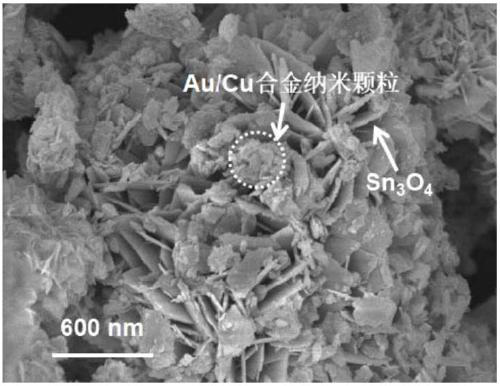Preparation method of Au/Cu co-modified Sn3O4 nano composite photocatalytic material
A photocatalytic material and nanocomposite technology, which is applied in the field of preparation of nanocomposite photocatalysts, can solve the problems of obvious hard agglomeration effect of samples, easy falling off of supported metals, complicated preparation process, etc., and achieve controllable shape and size, shape Controllable and low preparation temperature
- Summary
- Abstract
- Description
- Claims
- Application Information
AI Technical Summary
Problems solved by technology
Method used
Image
Examples
Embodiment 1
[0026] 1) get 1mmol analytically pure stannous tartrate (C 4 h 4 o 6 Sn) and 0.2mmol of tartaric acid (C 4 h 6 o 6 ), fully dissolved in 5mL of dehydrated ethanol, followed by adding 2mmol of dodecyl ethoxy sulfobetaine and 10mL of deionized water to completely dissolve to obtain solution A;
[0027] 2) Take 1mmol analytically pure auric acid chloride (HAuCl 4 ), 1mmol of copper nitrate (Cu(NO 3 ) 2 ) and 0.03mmol of tartaric acid (C 4 h 6 o 6 ) was fully dissolved in 5mL of deionized water, and mixed uniformly to obtain solution B;
[0028] The steps 1 and 2) in the ice-salt bath composed of NaCl and crushed ice use a constant temperature magnetic stirring device to carry out continuous magnetic stirring at a temperature of -5°C;
[0029] 3) Add solution B dropwise to solution A at a rate of 30 drops / min, and then use 3mol / L NaOH solution to adjust its pH to 4. The whole process uses a constant temperature magnetic force in an ice-salt bath composed of NaCl and cru...
Embodiment 2
[0033] 1) get 1mmol analytically pure stannous tartrate (C 4 h 4 o 6 Sn) and 1.6mmol of tartaric acid (C 4 h 6 o 6 ), fully dissolved in 11mL of absolute ethanol, followed by adding 7mmol of dodecyl ethoxy sulfobetaine and 15mL of deionized water to completely dissolve to obtain solution A;
[0034] 2) Take 1mmol analytically pure auric acid chloride (HAuCl 4 ), 5mmol of copper nitrate (Cu(NO 3 ) 2 ) and 3mmol of tartaric acid (C 4 h 6 o 6 ) was fully dissolved in 7mL of deionized water, and mixed uniformly to obtain solution B;
[0035] The steps 1 and 2) use a constant temperature magnetic stirring device to carry out continuous magnetic stirring at a temperature of 10° C. in an ice-salt bath composed of NaCl and crushed ice;
[0036] 3) Add solution B dropwise to solution A at a rate of 50 drops / min, and then adjust its pH value to 6.5 with 6mol / L NaOH solution. The whole process uses a constant temperature magnetic force in an ice-salt bath composed of NaCl and ...
Embodiment 3
[0041] 1) get 1mmol analytically pure stannous tartrate (C 4 h 4 o 6 Sn) and 3mmol of tartaric acid (C 4 h 6 o 6 ), fully dissolved in 15mL of absolute ethanol, followed by adding 12mmol of dodecyl ethoxy sulfobetaine and 20mL of deionized water to completely dissolve to obtain solution A;
[0042] 2) Take 1mmol analytically pure auric acid chloride (HAuCl 4 ), 10mmol of copper nitrate (Cu(NO 3 ) 2 ) and 5mmol of tartaric acid (C 4 h 6 o 6 ) was fully dissolved in 18mL of deionized water, and mixed uniformly to obtain solution B;
[0043] The steps 1 and 2) in the whole process, use a constant temperature magnetic stirring device to carry out continuous magnetic stirring at a temperature of 30 ° C in an ice-salt bath composed of NaCl and crushed ice;
[0044] 3) Add solution B dropwise to solution A at a rate of 60 drops / min, and then adjust its pH value to 9 with 10mol / L NaOH solution. The whole process uses constant temperature magnetic force in an ice-salt bath c...
PUM
 Login to View More
Login to View More Abstract
Description
Claims
Application Information
 Login to View More
Login to View More - R&D
- Intellectual Property
- Life Sciences
- Materials
- Tech Scout
- Unparalleled Data Quality
- Higher Quality Content
- 60% Fewer Hallucinations
Browse by: Latest US Patents, China's latest patents, Technical Efficacy Thesaurus, Application Domain, Technology Topic, Popular Technical Reports.
© 2025 PatSnap. All rights reserved.Legal|Privacy policy|Modern Slavery Act Transparency Statement|Sitemap|About US| Contact US: help@patsnap.com

